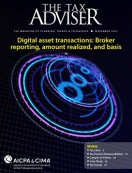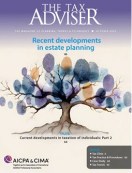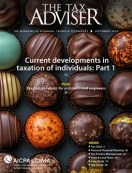- tax clinic
- STATE & LOCAL TAXES
States continue to tweak NOL provisions
Related
Commonly overlooked business property tax compliance and valuation issues
P.L. 86-272 and the evolution of nexus in the digital age
Outlier or beginning of a trend? Illinois redefines investment partnerships
TOPICS
Editor: Greg A. Fairbanks, J.D., LL.M.
In response to federal changes to net operating losses (NOLs) and fluctuating fiscal conditions, several states have recently enacted noteworthy legislation that changes the amount of state NOL attributes that taxpayers may utilize.
The treatment of NOLs under federal law has changed since 2017, with many states decoupling from federal law and taking their own approach. States often vary on whether the NOL deduction is limited to a certain amount or percentage of taxable net income for the tax year, as well as the length of NOL carryforward periods (and in limited instances, the use of carryback provisions). The differing treatment of NOLs by states and the multiyear nature of the deduction for some taxpayers require careful planning and consideration. Given the disparity between federal and state NOL regimes and the ability of states to effectively and efficiently tweak aspects of their own tax systems when necessary, taxpayers have significant work to do to keep informed with respect to their overall federal and state NOL attribute profile.
Three years ago, the authors of this item published a Tax Clinic item in The Tax Adviser on this topic (Yesnowitz et al., “Recent Developments Involving Limitations to State NOL Usage,” 53-2 The Tax Adviser 29 (February 2022)). This current item provides an update by discussing the major NOL legislation enacted by California, Illinois, and Pennsylvania during 2024, as well as legislation enacted by Minnesota in 2023 that is effective beginning with the 2024 tax year. Finally, this item covers the recent extension of NOL carryforward periods enacted by Connecticut and Rhode Island.
Federal treatment of NOLs
The treatment of NOLs as provided in Sec. 172 is complicated by changes in the federal law enacted beginning in 2017. Prior to this legislation, NOLs could be deducted against 100% of annual income under federal law. Excess NOL amounts could be carried back two years and carried forward 20 years. As amended by the Tax Cuts and Jobs Act (TCJA), P.L. 115-97, NOL deductions may only offset up to 80% of taxable income. The legislation also repealed NOL carrybacks but allows indefinite carryforwards. In 2020, the Coronavirus Aid, Relief, and Economic Security (CARES) Act, P.L. 116-136, temporarily suspended the TCJA’s 80% taxable income limitation to allow NOLs to be fully deductible for tax years beginning after Dec. 31, 2017, and before Jan. 1, 2021. Also, while NOL carrybacks were eliminated under the TCJA, the CARES Act allowed taxpayers to carry back any NOL generated in a tax year beginning in 2018, 2019, or 2020 for up to five years to offset income from prior tax years.
California
On June 27, 2024, California enacted the revenue trailer bill for the 2024—25 budget, Ch. 34 (S.B. 167), which suspends the use of NOLs for most California corporate and personal income taxpayers for tax years beginning in 2024—2026 unless a limited small business exception applies. To the extent that the NOL utilization is suspended by the new statutes, a corollary extension of the NOL carryover period is provided for each year of disallowance. For purposes of the corporate tax, the NOL suspension does not apply if the taxpayer has income subject to corporate tax of less than $1 million for the tax year. For personal income tax purposes, the NOL suspension does not apply if a taxpayer has either net business income or modified adjusted gross income of less than $1 million for the tax year.
As amended by a second budget trailer bill, Ch. 42 (S.B. 175), which was enacted two days after the original revenue trailer bill, the NOL suspension for corporate tax and personal income tax purposes will not apply for the 2025 and 2026 tax years if the director of the California Department of Finance determines that the general fund money over the multiyear forecast is sufficient without the revenue from the NOL suspension and accompanying tax credit limitation, and there is legislation in the annual budget act to not apply these provisions.
The three-year NOL suspension for the 2024—2026 tax years should be familiar to taxpayers because, historically, a similar approach has been followed on several occasions. Most recently, legislation was enacted in 2020 that suspended NOLs for the 2020—2022 tax years, but subsequent legislation in 2022 provided that the NOL suspension did not apply to the 2022 tax year. The NOL suspension is intended to provide fiscal relief for the state, but the unpredictable nature of this provision from year to year will make tax planning difficult for many taxpayers. Taxpayers should immediately consider the potential effects of the NOL limitation because it first applies to the 2024 tax year retroactively, and, as such, may impact tax provisions and estimated tax payments for the tax year.
Illinois
On June 7, 2024, Illinois enacted legislation, P.A. 103-0592 (H.B. 4951), which extends and raises an existing NOL deduction limitation for three years. For tax years ending on or after Dec. 31, 2024, and prior to Dec. 31, 2027, the maximum amount of an NOL that a C corporation may deduct is limited to $500,000. Prior to amendment, the limitation was $100,000 for tax years ending on or after Dec. 31, 2021, and prior to Dec. 31, 2024. Although the legislation originally was designed to make the NOL deduction limitation provision permanent, the legislature ultimately decided to only impose the limitation for three more years. Increasing the amount of the annual limitation is likely to help some small businesses utilize historic NOL deductions in a more efficient manner. This limitation only applies to C corporations and does not apply to S corporations or individuals. Unlike California, Illinois did not extend the NOL carryforward period for disallowed NOL deductions as part of the legislation. As a result, the standard 20-year NOL carryforward period applies.
In July 2024, the Illinois Department of Revenue issued Informational Bulletin FY 2025-01, which discusses the NOL legislation and addresses the effect on estimated tax payments. The guidance notes that taxpayers that calculated their estimated payments without considering an NOL limitation may need to begin making estimated tax payments or increase their estimated tax payments for the remainder of the tax year to avoid or minimize the late-payment penalty for underpayment of estimated tax due.
Minnesota
In May 2023, Minnesota enacted legislation, Ch. 64 (H.F. 1938), limiting the amount of the corporate income tax NOL deduction to 70% (previously 80%) of taxable net income in a single tax year. As originally enacted, this change was effective for tax years beginning in 2023 and thereafter. However, the fiscal spreadsheet noting the revenue impact of the legislation indicated that the change in the NOL limitation was effective for tax years Jan. 1, 2024, and beyond. There also was some discussion among legislators, staff, and other interested parties that this was a drafting error and that the intention was for the provision to become effective Jan. 1, 2024, per the fiscal analysis. On April 8, 2024, Minnesota enacted legislation, Ch. 82 (H.F. 3769), which remedies this issue by retroactively amending the effective date of the NOL limitation reduction to tax years beginning in 2024 and thereafter.
As explained on the Minnesota Department of Revenue’s website, for tax years beginning in 2018 through 2023, the NOL deduction is limited to 80% of the corporation’s taxable income. For tax years beginning in 2024 and beyond, the NOL deduction is limited to 70% of the corporation’s taxable income. Minnesota law does not distinguish between NOL carryovers generated before or after the law change. The 70% limitation makes the NOL deduction less favorable than the deduction provided by most states. This adverse treatment is compounded by the fact that Minnesota only has a 15-year carryforward period.
Pennsylvania
Historically, Pennsylvania’s net loss carryover (NLC) deduction for corporate net income tax purposes has been extremely limited, with numerous complexities and changes for taxpayers to navigate. Since the 2018 tax year, the NLC deduction has been limited to 40% of post-apportionment taxable income. On July 11, 2024, Pennsylvania enacted omnibus budget legislation, Act 56 (S.B. 654), which increases the NLC deduction limitation over a four-year period, increasing the current 40% cap in 10% annual increments from the 2026 tax year to the 2029 tax year. Accordingly, the NLC deduction limitation will align with the federal limitation of 80% of taxable income for tax years beginning in 2029 and thereafter.
In order to retain the previous 40% limitation for net losses incurred in pre-2025 tax years, the legislation provides a unique formula for calculating the NLC deduction limitation involving net losses incurred in both pre-2025 tax years and post-2024 tax years. For net losses incurred in a pre-2025 tax year, the deduction remains at 40% of taxable income. For net losses incurred in a post-2024 tax year, the taxpayer uses the actual percentage applicable for the tax year (ranging from 40% to 80%, based on the tax year in question), and subtracts the actual percentage of taxable income deducted from the pre-2025 net losses. That result is then multiplied by the taxable income for the year and added to the deduction claimed for pre-2025 losses.
Given that the Pennsylvania NLC limitation has been historically more restrictive than it is in other states, the increased limitation is designed to make Pennsylvania more competitive with neighboring states in attracting and retaining corporate businesses. With the complex calculation of the NLC deduction limitation and the resulting need to separate net losses into two groups depending on the year incurred, taxpayers will need to track net losses by year until pre-2025 losses are fully utilized and consider the resulting financial impact for tax provision purposes. Pennsylvania continues to have a 20-year carryforward period.
Two states extend NOL carryforward periods
While the federal NOL provisions now allow for unlimited carryforward periods, as reflected above, not all states follow this policy. The trend, however, has been favorable for taxpayers in recent years, even in many of the states that did not automatically conform to the new TCJA rules. In 2024, Connecticut and Rhode Island extended their NOL carryforward periods. For operating losses incurred in income years beginning on or after Jan. 1, 2025, Connecticut enacted legislation, Act 24-151 (H.B. 5524), increasing the carryover period from 20 income years to 30 income years following the loss. Rhode Island enacted legislation, Ch. 117 (H.B. 7225), which extends the NOL carryforward period from five to 20 years for any tax year beginning on or after Jan. 1, 2025. By increasing the length of the carryforward periods, these states are improving the ability of taxpayers to fully deduct their unused NOLs.
Implications of recent state NOL changes
It may come as a surprise to many taxpayers that states do not automatically incorporate all the federal NOL rules for purposes of the state NOL attribute and that some of these state-level changes are driven primarily by temporal state budget considerations and projections. Therefore, the changes discussed above should be carefully considered by taxpayers that have NOLs and expect to be profitable and in a position to use the NOLs to offset otherwise taxable income.
As states continue to pursue their own independent paths on the ability to use NOL attributes, it stands to reason that developments in this area can have positive implications for certain taxpayers but not for others. The Pennsylvania legislation is taxpayer-favorable because it will gradually increase the NLC limitation over the next few years and allow profitable taxpayers to potentially use their loss attributes more quickly. However, the legislation will require additional computations by retaining the 40% limitation for pre-2025 NLCs while increasing the limitation for post-2024 NLCs. In addition, the legislation enacted by Connecticut and Rhode Island is a positive development for taxpayers by increasing the length of the carryforward period. In contrast, the Illinois legislation is unfavorable to most taxpayers because the state NOL limitation was continued for three years, but positive for a few well-positioned small businesses since the amount of the NOL limitation is being increased from prior law. As for California’s suspending the use of NOLs for most taxpayers for three years and Minnesota’s decreasing the percentage of the NOLs that may be taken each year, businesses with significant presence in these states may face a delay in using NOL attributes that may have been created when the NOL utilization rules were less restrictive.
Editor Notes
Greg A. Fairbanks, J.D., LL.M., is a tax managing director with Grant Thornton LLP in Washington, D.C.
For additional information about these items, contact Fairbanks at greg.fairbanks@us.gt.com.
Contributors are members of or associated with Grant Thornton LLP.














